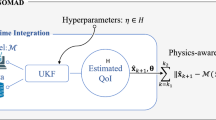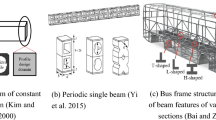Abstract
Efficient optimum design of plate structures is achieved with stress, displacement and frequency constraints. To reduce the computational cost of optimum design, attempts have been made to reduce the number of static and dynamic analyses required in the process. To achieve this goal, all the quantities that are the output of analysis are approximated. By substituting these approximate functions into the original design problem, an approximate problem is obtained which can be solved by numerical optimization techniques efficiently. This is one cycle which does not require the analysis of the structure. The resulting solution is used as a starting design point for the next iteration. This process is repeated until the problem converges. The efficiency of the method is based on the creation of high quality approximation of the functions under consideration and thus reducing the number of iterations. A three-point approximation is developed to approximate the forces and the Rayleigh quotient. Numerical examples are offered and the results are compared with previous published work.
Similar content being viewed by others
References
Afonso, S.M.B.; Hinton, E. 1995: Sensitivity analysis of shells undergoing static deformation or free vibration. In: Topping, B.H.V. (ed.)Developments in computational techniques for structural engineering, pp. 273–285. Edinburgh: Civil-Comp Press
Canfield, R.A. 1990: High-quality approximation of eigenvalues in structural optimization.AIAA J. 28, 1116–1122
Fadel, G.M.; Riley, M.F.; Barthelemy, J.F.M. 1990: Two-point exponential approximation method for structural optimization.Struct. Optim. 6, 117–124
Grandhi, R.V.; Bharatram, G.; Venkayya, V.B. 1992: Optimum design of plate structures with multiple frequency constraints.Struct. Optim. 5, 100–107
Olhoff, N.; Rasmussen, J.; Lund, E. 1993: Method of exact numerical differentiation for error estimation in finite element based semianalytical shape sensitivity analysis.Mech. Struct. Mach. 21, 1–66
Salajegheh, E. 1994: A two level approximation technique for structural optimization.Int. J. Eng. 7, 85–93
Salajegheh, E. 1995a: Optimum design of plate and shell structures with discrete design variables.Asian J. Struct. Eng. 1, 1–15
Salajegheh, E. 1995b: Optimum design of structures with frequency constraints.Asian J. Struct. Eng. 1, 243–254
Salajegheh, E. 1995c: Approximate discrete variable optimization of plate structures using dual methods.Struct. Eng. & Mech. 3, 359–372
Salajegheh, E. 1995d: Optimum design of structures with reference to space structures.Int. J. Space Struct. 10, 205–214
Salajegheh, E. 1996a: Approximate discrete variable optimization of frame structures with dual methods.Int. J. Num Eng. 39, 1607–1617
Salajegheh, E. 1996b: Discrete variable optimization of plate structures using dual methods.Comp. & Struct. 58, 1131–1138
Salajegheh, E. 1996c: Discrete variable optimization of plate structures using penalty approaches and approximation concepts.Eng. Opt. 26, 195–205
Salajegheh, E. 1997: Optimum design of plate structures with frequency constraints.Eng. Comput. (accepted)
Salajegheh, E.; Vanderplaats, G.N. 1986/87: An efficient approximation method for structural synthesis with reference to space structures.Int. J. Space Struct. 2, 16
Salajegheh, E.; Vanderplaats, G.N. 1993a: Efficient optimum design of structures with discrete design variables.Int. J. Space Struct. 8, 199–208
Salajegheh, E.; Vanderplaats, G.N. 1993b: Optimum design of trusses with discrete sizing and shape variables.Struct. Optim. 6, 79–85
Vanderplaats, G.N. 1991:DOT user's manual. Goleta, CA: VMA Engineering
Vanderplaats, G.N.; Salajegheh, E. 1989: An efficient approximation technique for frequency constraints in frame optimization.Int. J. Num. Meth. Eng. 26, 1057–1069
Vanderplaats, G.N.; Thomas, H.L. 1993: An improved approximation for stress constraints in plate structures.Struct. Optim. 6, 1–7
Wang, L.; Grandhi, R.V. 1994: Efficient safety index calculations for structural reliability analysis.Comp. & Struct. 52, 103–111
Wang, L.; Grandhi, R.V. 1995a: Improved two-point function approximation for design optimization.AIAA J. 33, 1720–1727
Wang, L. Grandhi, R.V. 1995b: Recent multi-point approximations in structural optimization. In: Olhoff, N.; Rozvany, G.I.N. (eds.)WCSMO 1—First World Congress of Structural and Multidisciplinary Optimization (held in Goslar, May 28–June 2, 1995), pp. 75–82, Oxford: Pergamon
Author information
Authors and Affiliations
Rights and permissions
About this article
Cite this article
Salajegheh, E. Optimum design of plate structures using three-point approximation. Structural Optimization 13, 142–147 (1997). https://doi.org/10.1007/BF01199233
Received:
Issue Date:
DOI: https://doi.org/10.1007/BF01199233




